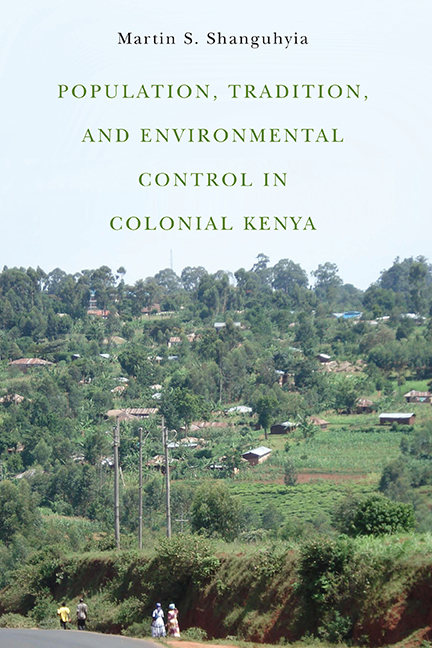Book contents
- Frontmatter
- Contents
- List of Illustrations
- Preface
- Abbreviations
- Introduction
- 1 Administrative and Demographic Changes: Implications on Land Relations, 1900–1930
- 2 Maize and Economic Prosperity, 1920–38
- 3 Internationalizing Degradation Narratives in Kenya, 1930–38
- 4 Prewar Soil Conservation Initiatives and Local Responses, 1934–38
- 5 Wartime Production in a Besieged Environment, 1939–45
- 6 Postwar Development and the Dilemma of “Reviving” African Traditions, 1945–63
- 7 Regional Migration and Failed Agricultural Intensification, 1940–66
- Conclusion
- Notes
- Bibliography
- Index
- Frontmatter
- Contents
- List of Illustrations
- Preface
- Abbreviations
- Introduction
- 1 Administrative and Demographic Changes: Implications on Land Relations, 1900–1930
- 2 Maize and Economic Prosperity, 1920–38
- 3 Internationalizing Degradation Narratives in Kenya, 1930–38
- 4 Prewar Soil Conservation Initiatives and Local Responses, 1934–38
- 5 Wartime Production in a Besieged Environment, 1939–45
- 6 Postwar Development and the Dilemma of “Reviving” African Traditions, 1945–63
- 7 Regional Migration and Failed Agricultural Intensification, 1940–66
- Conclusion
- Notes
- Bibliography
- Index
Summary
It has been almost fifteen years since a major study has focused on the history of soil erosion and conservation in colonial Africa. David Anderson's Eroding the Commons elucidated colonial politics of conserving the soil in the lowlands of Baringo in north-central Rift Valley in Kenya. Other studies focusing on this and related themes followed in the subsequent years; but Anderson's work, a masterful account of this aspect of Kenya's colonial history, provided an inspiration for my engagement with this subject. I decided to study the theme in a different geographical area of the Kenya Colony, away from the Rift Valley—and Central Province—where, I thought, land issues were not overly sensitive or explosive for the most part of the colonial era. Ideally, this caused me to drift toward western Kenya where, although colonial land policies generated acrimonious relations between the Abaluyia and the British colonial state, this was more due to the politics of land management than to massive dislocation of communities caused by land alienation in the early years of British administration. No doubt, isolated cases of land disposition in western Kenya reinforced local anticolonial feelings, particularly in the 1930s; but, as I ventured deeper into the colonial archive and engaged the elderly Abaluyia folks in conversation, numerous contradictions clearly emerged from the colonial policies designed to maximize agricultural production while pushing the local residents to preserve the land, in that they also contributed to a rural backlash against those policies.
While political conflicts over land were inevitable in a settler colony such as Kenya, my interest in the subject and the geographical area of focus grew even more with the realization that demography and local traditions seemed to drive the colonial debate about confronting soil erosion, especially in the densely settled area of Vihiga. Those two aspects—demography and indigenous traditions—were also responsible for the tensions that emerged between the colonial state and a section of the Abaluyia community, as well as among various members of this community. This realization offered opportunities to revisit the subject of soil erosion and conservation in colonial Africa, also an overarching issue throughout the British Empire, by seeking to expound on the social interpretation of the developments that attended this colonial project.
- Type
- Chapter
- Information
- Publisher: Boydell & BrewerPrint publication year: 2015



